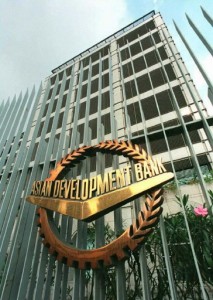HONG KONG — Economic growth in developing Asia is picking up, underpinned by China’s rebound and strength in countries such as Indonesia, the Asian Development Bank said in a report Tuesday, while warning that political disputes pose an increased threat to growth.
The Manila-based lender’s 2013 Asian Development Outlook said some big dangers to regional growth have faded, such as the possibility of the euro common currency breaking up or a “US fiscal shock” stemming from brinkmanship over the debt ceiling in the world’s biggest economy.
But it said that “political risks are emerging as the main threats to the region’s continued robust growth.” Political disputes are “calling into question the ability of authorities to find compromise solutions to nagging fiscal problems in the US, deepening austerity fatigue in the euro area and simmering border disputes in Asia.”
Over the past year, several Asia nations have been roiled by territorial disputes, including a high-profile row between China and Japan over disputed islands in the East China Sea.
The ADB said developing Asia, which includes giant emerging economies such as China, India and Indonesia, will expand 6.6 percent this year, unchanged from its previous forecast in December. Growth is forecast to inch higher to 6.7 percent in 2014. The region grew 6.1 percent in 2012,
Developing Asia includes 45 developing or newly industrialized countries in Asia and the Pacific but excludes Japan.
The ADB said inflation would tick higher but would be kept in check, with consumer prices rising by 4 percent this year and 4.2 percent in 2014, up from 3.7 percent in 2012. The report warned policymakers to keep an eye on rising prices because as growing factory output eliminates slack in production capacity, “loose monetary policy risks reigniting inflation.”
China’s economy, the world’s second biggest, will expand 8.2 percent this year after growing 7.8 percent in 2012, driven by strong domestic consumption and investment. The forecasts are both 0.1 percentage point higher than the ADB’s December prediction.
China is rebounding from its deepest slump since the 2008 global crisis though analysts warn recovery will be shaky. China’s growth rate will ease to 8 percent in 2014 as authorities bring in policies aimed at reducing pollution and reducing the gap between rich and poor, the ADB said.
Southeast Asia, the only region covered in the report that didn’t slow last year, will maintain its growth rate as robust private consumption and investment outweigh softer demand for exports. Indonesia will expand about 6.5 percent in each of the next two years while the Philippines will grow about 6 percent.
India, the region’s other giant, will expand 6 percent this year and 6.5 percent next year, the report said, but warned that the country risks being held back by structural and policy issues that hamper investment.
In contrast, the developed economies of the US, Japan and the 17 nations the use the euro will eke out a 1 percent expansion this year, rising to 1.9 percent in 2014.
The ADB also warned that Asia needs to secure enough clean and cheap energy to support long-term growth. With developing Asia’s share of global energy use forecast to grow from barely a third in 2010 to more than half by 2035, the region, which has plenty of coal but relatively little oil and natural gas, may be hard pressed to meet its demands.
“With insufficient energy, developing Asia would need to scale back its growth ambitions,” said the report, which recommended curbing general energy subsidies in favor of targeted ones, tapping cleaner energy sources such as wind, solar and biofuels, and integrating gas and electricity networks to create a regional market.
